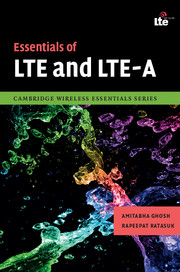Book contents
3 - Downlink transmission and system performance
Published online by Cambridge University Press: 05 August 2011
Summary
Introduction
In this chapter the details of LTE downlink transmission are discussed. The LTE downlink air interface uses the OFDM multiple-access technique described in Chapter 2. The use of OFDM transmission technology provides significant advantages over other radio transmission techniques. They include high spectral efficiency, support for broadband data transmission, the absence of intra-cell interference (i.e. multiple users in the same cell can share the same subframe without interfering with each other), resistance to inter-symbol interference arising from multipath operation, natural support for MIMO schemes, a low-complexity receiver, and support for frequency-domain techniques such as frequency-selective scheduling, a single-frequency network, and soft fractional frequency reuse. In addition to OFDM, LTE also utilizes several other features to enhance system performance and user experience. They include short frame size to minimize latency, a single-frequency network to provide high-data-rate broadcast services, VoIP support to increase voice capacity, coverage for very large cells, and coverage for high-speed users (up to 350 km/h) [1]–[2].
- Type
- Chapter
- Information
- Essentials of LTE and LTE-A , pp. 33 - 76Publisher: Cambridge University PressPrint publication year: 2011



